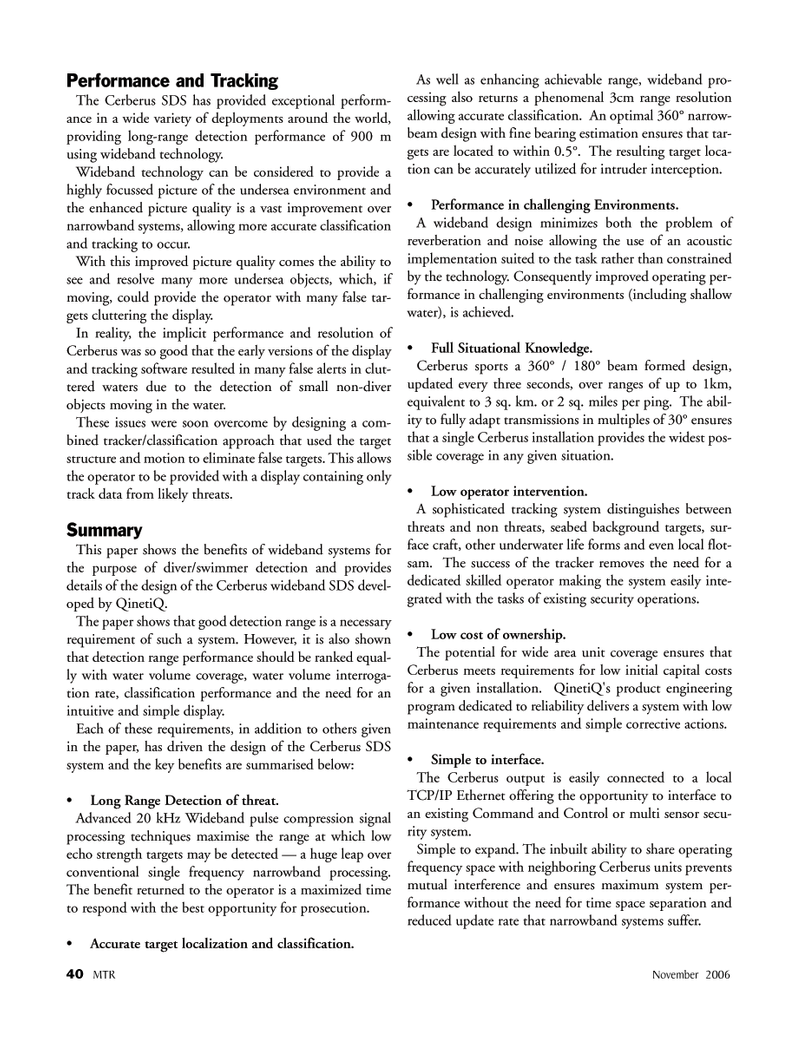
Page 40: of Marine Technology Magazine (November 2006)
Deep Ocean Exploration
Read this page in Pdf, Flash or Html5 edition of November 2006 Marine Technology Magazine
Performance and Tracking
The Cerberus SDS has provided exceptional perform- ance in a wide variety of deployments around the world, providing long-range detection performance of 900 m using wideband technology.
Wideband technology can be considered to provide a highly focussed picture of the undersea environment and the enhanced picture quality is a vast improvement over narrowband systems, allowing more accurate classification and tracking to occur.
With this improved picture quality comes the ability to see and resolve many more undersea objects, which, if moving, could provide the operator with many false tar- gets cluttering the display.
In reality, the implicit performance and resolution of
Cerberus was so good that the early versions of the display and tracking software resulted in many false alerts in clut- tered waters due to the detection of small non-diver objects moving in the water.
These issues were soon overcome by designing a com- bined tracker/classification approach that used the target structure and motion to eliminate false targets. This allows the operator to be provided with a display containing only track data from likely threats.
Summary
This paper shows the benefits of wideband systems for the purpose of diver/swimmer detection and provides details of the design of the Cerberus wideband SDS devel- oped by QinetiQ.
The paper shows that good detection range is a necessary requirement of such a system. However, it is also shown that detection range performance should be ranked equal- ly with water volume coverage, water volume interroga- tion rate, classification performance and the need for an intuitive and simple display.
Each of these requirements, in addition to others given in the paper, has driven the design of the Cerberus SDS system and the key benefits are summarised below: • Long Range Detection of threat.
Advanced 20 kHz Wideband pulse compression signal processing techniques maximise the range at which low echo strength targets may be detected — a huge leap over conventional single frequency narrowband processing.
The benefit returned to the operator is a maximized time to respond with the best opportunity for prosecution. Accurate target localization and classification.
As well as enhancing achievable range, wideband pro- cessing also returns a phenomenal 3cm range resolution allowing accurate classification. An optimal 360° narrow- beam design with fine bearing estimation ensures that tar- gets are located to within 0.5°. The resulting target loca- tion can be accurately utilized for intruder interception. Performance in challenging Environments.
A wideband design minimizes both the problem of reverberation and noise allowing the use of an acoustic implementation suited to the task rather than constrained by the technology. Consequently improved operating per- formance in challenging environments (including shallow water), is achieved. Full Situational Knowledge.
Cerberus sports a 360° / 180° beam formed design, updated every three seconds, over ranges of up to 1km, equivalent to 3 sq. km. or 2 sq. miles per ping. The abil- ity to fully adapt transmissions in multiples of 30° ensures that a single Cerberus installation provides the widest pos- sible coverage in any given situation. Low operator intervention.
A sophisticated tracking system distinguishes between threats and non threats, seabed background targets, sur- face craft, other underwater life forms and even local flot- sam. The success of the tracker removes the need for a dedicated skilled operator making the system easily inte- grated with the tasks of existing security operations. Low cost of ownership.
The potential for wide area unit coverage ensures that
Cerberus meets requirements for low initial capital costs for a given installation. QinetiQ's product engineering program dedicated to reliability delivers a system with low maintenance requirements and simple corrective actions. Simple to interface.
The Cerberus output is easily connected to a local
TCP/IP Ethernet offering the opportunity to interface to an existing Command and Control or multi sensor secu- rity system.
Simple to expand. The inbuilt ability to share operating frequency space with neighboring Cerberus units prevents mutual interference and ensures maximum system per- formance without the need for time space separation and reduced update rate that narrowband systems suffer. 40 MTR November 2006
MTR#9 (33-48).qxd 11/13/2006 4:38 PM Page 40

 39
39

 41
41
